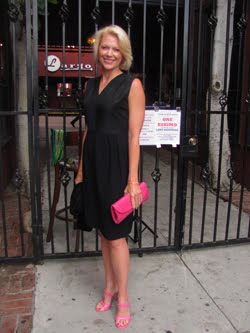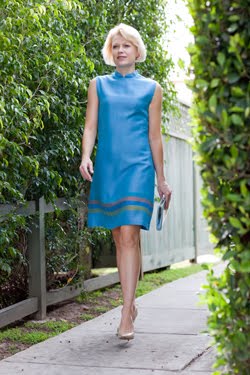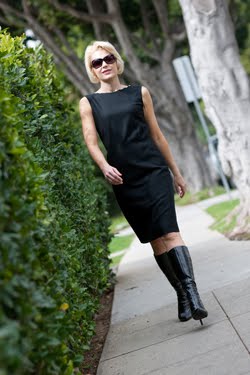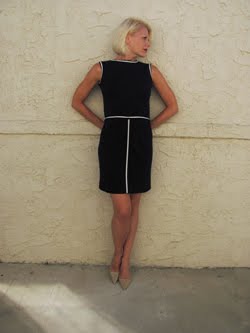Warner Brothers is an integral part of Los Angeles history, and I was fortunate enough to take a behind-the-scenes tour of the legendary studio last week. It incorporated 90 years ago in 1923 and is one of the first film studios in Hollywood. Founded by four immigrant brothers--Harry, Albert, Sam, and Jack--who came from very modest means to build an empire, which started simply by selling a horse to buy a projector. This was followed by building a theater (below, 1924), acquiring a means of distribution, and merging with First National. There was no holding these brothers back when they set their minds to making the most of the new medium of film.
Some of what makes this studio so fascinating is the dynamic between its very different brothers. It ranged from those responsible for finances and often acting the diplomat (like Harry) to those who were much more heated and possessed a very certain creative vision (like Jack). Jack was so tough, in fact, he was infamous for his fights and firings, which included stars like Douglas Fairbanks Jr. It is perhaps due to this very dichotomy within the family and their often conflicting vision that the studio was so dynamic and ahead of its time. On a personal level, it has always been particularly meaningful to me as many of my favorite films are Warner Brothers productions. You'll see many of them listed below.
Every era had groundbreaking films. In the 1920s, you can thank Warner Brothers for the first synchronized sound (1927's The Jazz Singer, below) and first all-talking picture (1928's Lights of New York). Though the industry tried to resist at first, audiences demanded it and by 1929 almost all pictures were "talkies."
Every era had groundbreaking films. In the 1920s, you can thank Warner Brothers for the first synchronized sound (1927's The Jazz Singer, below) and first all-talking picture (1928's Lights of New York). Though the industry tried to resist at first, audiences demanded it and by 1929 almost all pictures were "talkies."
This legacy is the reason I was so excited to visit Warner Brothers as part of the tour to celebrate their 90th anniversary. Too few seem to appreciate this great studio's history, so I am excited to now have the opportunity to do so. Though always known for being somewhat tough--both onscreen and off--Warner Brothers is responsible for some of the best movies of all time, including one that many consider THE best of all time--1942's Casablanca. It is but one example of a movie from Warner Brothers whose dialogue we all know. One of its famous lines kept floating through my head as I walked the same steps as all of the stars I mentioned above--"This is the beginning of a beautiful friendship." I think you'll feel the same...take the tour for yourself.
Warner Brothers Studios in late 1920s...
...and again today
Map of the lot...our tour started at the Studio Plaza in the north part of the studio
and headed southwest toward Stage 7
In front of mighty Stage 7, which was home to iconic films such as
Casablanca, The Big Sleep, Ocean's 11, Rebel Without a Cause, and Dark Victory
The exterior for Casablanca's La Belle Aurore still stands on the lot
(thanks to Elise Crane Derby for the photo!)
There are a few of the Casablanca pianos on the lot...an original we could not photograph
and a reproduction (below, right) kept in the enormous prop department
Loved seeing a candelabra from The Maltese Falcon (below) on the former TV set of Friends
Enjoyed meeting and talking with Harry Warner's granddaughter--filmmaker and author Cass Warner--
before admiring costumes worn by icons Bette Davis (red) and Elizabeth Taylor (black)
Baz Luhrmann's The Great Gatsby is proudly displayed in many ways at Warner Brothers,
from the Duesenberg to all of Catherine Martin's costumes in the museum and refrigerated storage
Men's hats and ties fill the vast Warner Brothers costume design department
To protect the colored furs and feathered boas,
all costumes and accessories from The Great Gatsby are kept in cold storage
Just some of the incredible Art Deco headpieces from The Great Gatsby all boxed up
One of the many streets on the WB backlot includes these brownstones...
this one is where Audrey Hepburn filmed some exteriors for Wait Until Dark
Thanks to everyone at Warner Brothers--I had such an incredible time.
If you love film history, sign up to take the WB VIP Studio tour for yourself!
























































































































2 comments:
What a wonderful tour – and even better photos! Thanks for sharing this experience with us.
My husband & I were able to take the Warner Bros. VIP Tour a couple of years ago, and your account has brought back a lot of wonderful memories...
Thanks Silver Screenings! I loved being there, though would have loved to experience their archives more. A lot of the tour is oriented toward current projects versus the classics we love. But of course we know so much of what was produced there, so it was all sacred ground to me. :)
Post a Comment